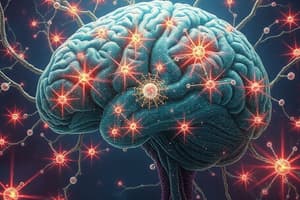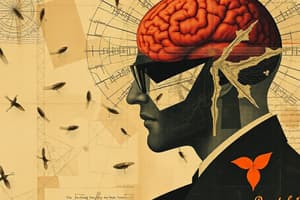Podcast
Questions and Answers
What major insight did Santiago Ramón y Cajal contribute to our understanding of the nervous system?
What major insight did Santiago Ramón y Cajal contribute to our understanding of the nervous system?
- The nervous system is a continuous web of connected cells.
- Nerve cells are independent units that communicate with one another. (correct)
- Brain function is controlled by a single central cell.
- The nervous system consists mainly of blood vessels.
What was the significance of modifying Golgi's staining technique for Cajal's research?
What was the significance of modifying Golgi's staining technique for Cajal's research?
- It allowed the measurement of the size of nerve cells.
- It revealed new types of neurological diseases.
- It improved the visibility of individual cells in the brain. (correct)
- It facilitated the discovery of a new type of neuron.
Why was Cajal awarded the Nobel Prize in 1906?
Why was Cajal awarded the Nobel Prize in 1906?
- For his work on the structure of the nervous system. (correct)
- For discovering the function of neurotransmitters.
- For his drawings of the human brain.
- For developing new optical lenses.
How did Cajal’s background influence his scientific career?
How did Cajal’s background influence his scientific career?
What did Cajal publish in 1899?
What did Cajal publish in 1899?
What challenge did microscopes face before the 1870s when studying nervous system structures?
What challenge did microscopes face before the 1870s when studying nervous system structures?
What role did Cajal’s artistic ability play in his scientific achievements?
What role did Cajal’s artistic ability play in his scientific achievements?
What technological advancement helped Cajal in his studies of the nervous system?
What technological advancement helped Cajal in his studies of the nervous system?
What was one of Cajal's achievements in 1888?
What was one of Cajal's achievements in 1888?
Before focusing on histology, what did Cajal purchase for his studies?
Before focusing on histology, what did Cajal purchase for his studies?
Flashcards
Santiago Ramón y Cajal
Santiago Ramón y Cajal
Nobel Prize-winning neuroscientist who discovered nerve cells are independent.
Golgi's Staining Method
Golgi's Staining Method
A technique used to stain nervous tissue to make cells visible under a microscope.
Independent Nerve Cells
Independent Nerve Cells
Cajal's discovery that nerve cells are separate structures, not a continuous web.
Magnum Opus
Magnum Opus
Signup and view all the flashcards
Nobel Prize (1906)
Nobel Prize (1906)
Signup and view all the flashcards
Microscope Fund
Microscope Fund
Signup and view all the flashcards
Histology
Histology
Signup and view all the flashcards
Illuminated Brain Tissue
Illuminated Brain Tissue
Signup and view all the flashcards
Illustrations by Cajal
Illustrations by Cajal
Signup and view all the flashcards
Advancements in Microscopy
Advancements in Microscopy
Signup and view all the flashcards
Study Notes
Santiago Ramón y Cajal
- Nobel Prize-winning neuroscientist
- Explored nervous system organization using microscopes
- Realized nervous system composed of independent communicating cells
Milestones
- Turning Point: Observed Golgi's tissue-staining method, realizing its potential for his research. Developed the technique
- Technological Feat: Modified Golgi's stain, improving the illumination of human brain tissue.
Discredited Theory
- Contributed to the theory of nerve cells not being connected in a continuous web.
- Demonstrated nerve cells separated
Writes Magnum Opus
- Published the first volume of his major book on nervous system structure in 1899.
Prize Winner
- Shared Nobel Prize with Golgi for his work on nervous system structure in 1906
Cajal's Background
- Born in northern Spain with a passion for drawing
- Father was a doctor who instilled interest in anatomy
- Initially wanted to be an artist.
Microscopes and Staining
- Used microscopes starting his medical studies.
- Improved microscopes, increasing magnification
- Studied muscle and nervous tissue in detail
- Developed tissue stains to make individual cells more visible
- In 1887, observed stained brain tissue at the University of Barcelona.
Modified Golgi's Technique
- Developed and refined Golgi's tissue-staining technique
- Created numerous illustrations of the human nervous system and brain.
Studying That Suits You
Use AI to generate personalized quizzes and flashcards to suit your learning preferences.





